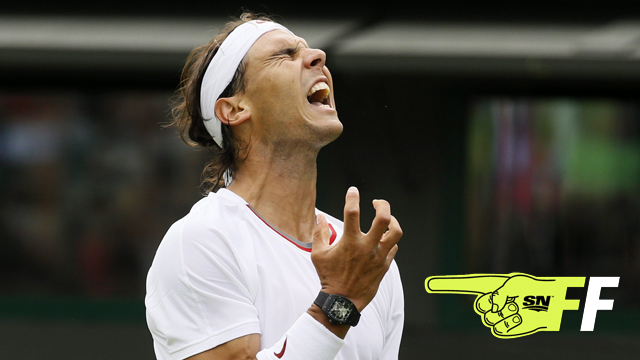BY WASIM PARKAR – FAN FUEL BLOGGER
On June 28, 2012 Rafael Nadal lost to world number 100 Lukas Rosol in the second round of Wimbledon. In an era of men’s tennis that has been highlighted by the consistent brilliance of Nadal, Roger Federer, Novak Djokovic and Andy Murray, this had to be the biggest upset in recent memory.
Fast forward one year, and on June 24, 2013 Nadal lost in the first round of Wimbledon to world number 135 Steve Darcis in straight sets, in what can easily be considered an even bigger upset than last year’s shock.
The magnitude of these shock results is put into clearer perspective when one considers he has come into Wimbledon both years on the back of impressive victories at Roland Garros. Just two weeks ago, Nadal won his eighth French Open and twelfth grand slam overall to reignite the debate on if he can overhaul Federer’s record of 17 grand slam wins.
The reversals against Rosol and Darcis have led some to question Nadal’s ability to handle the quick turnaround and transition between the end of the clay court season and the beginning of the grass court season.
 Have your say: Have an opinion on the news of the day? Better yet, want to become a Fan Fuel blogger? Email us here. | Read more Fan Fuel blogs here
Have your say: Have an opinion on the news of the day? Better yet, want to become a Fan Fuel blogger? Email us here. | Read more Fan Fuel blogs here
Let’s first give credit where it’s due. Nadal’s tennis upbringing was based on a complete mastery of clay. It was evident from the moment he broke through the ATP tour as a teenager, that he was going to be a special player on the slow surface. Despite possessing a game that wasn’t suited to grass, Nadal reached the finals at Wimbledon in 2006 and 2007, before finally winning the tournament in what many consider to be the best grand slam final of all time against Federer in 2008. Nadal followed it up with another Wimbledon win in 2010, and then losing in the final to Djokovic in 2011. Surely, a player who has reached five Wimbledon finals and coming out victorious on two occasions has grass court pedigree.
Nadal’s will to tenacity, dedication and hunger to win had led to him seeking new ways to improve his game on faster services. First and foremost, he changed his service action. During his early years on the circuit, Nadal possessed a loopy serve, with the left-handed angle allowing him a natural slice out to the right-handers backhand. While this was a great advantage on clay with its high bounce, many players realized they could capitalize on the return on faster services. Nadal made some changes in early 2008, resulting in a flatter and faster serve that enabled him to dominate on all surface, culminating in the achievement of the career grand slam with victory at the US Open in 2010.
Clearly then, Rafa is a champion who does possess the versatility and tactical acumen to succeed on all surfaces. So then why has he not won a grand slam other than the French Open since 2010? There are a few factors.
At the end of 2010, Nadal was the dominant player on tour. Heading into the Australian Open in 2011, Nadal had nine grand slam wins, and Djokovic just one. Few in the world of tennis could have seen Djokovic’s remarkable improvement and outright domination of the men’s circuit in 2011. For all intents and purposes Djokovic gave Nadal a dose of his own medicine. Never conceding defeat, hitting the most outrageous winners off both wings, Djokovic knows that at his best, he is better than Nadal on all surfaces except clay, and the results back that up.
Another factor in Nadal’s recent travails outside of Roland Garros is the weakening of his backhand as offensive weapon. On the slower clay, Nadal can negate this deficiency by running around his backhand an unloading his fearsome inside out forehand. However on faster surfaces, opponents know they can gain an advantage in rallies if they attack his backhand. Nadal doesn’t have the time and space to run around his backhand, often reverting to a slice that isn’t very effective.
Finally, the biggest factor could be the sheer physicality of his game. Compared to his peers at the top of men’s tennis, Nadal has missed the most amounts of Masters 1000 tournaments and grand slams. Could his absolute dedication to dominating the clay court season harm his physical and mental preparation for the summer season? As a result of his exhaustive schedule on clay, Nadal missed his grass court tune-ups in Halle this year and last, surely a factor that can’t be overlooked in his successive early round exits at Wimbledon.
At the age of 27, Nadal still has a few years left at the top of the game. A sportsman who thrives on proving his doubters wrong, Nadal could yet win many more Australian Opens, Wimbledons and US Opens. The nature of sports is such, that at 27 it is extremely difficult to make adjustments to one’s game, but if anyone can prove to be the exception, it certainly is Nadal.
Now that his grass court season is over for another year, the upcoming North American hard-court summer will tell us more about Nadal’s game on faster surfaces. Nadal’s performances in the hard court season from July to March will go quite a way in answering whether Nadal is the greatest player of all time, or more accurately the greatest clay court player of all time.


